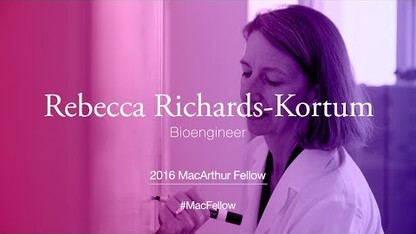
The 23 people recently named 2016 MacArthur Foundation Fellows include bioengineer Rebecca Richards-Kortum, a University of Nebraska-Lincoln graduate.
Richards-Kortum, now 52 and at Rice University, was recognized with the so-called “genius” award for her innovative work to deliver low-cost medical technology to Third World countries.
The McArthur is the latest accolade in a career of achievement. In 2008, Richards-Kortum was the first woman from Rice and the youngest member to be admitted to the National Academy of Engineering. In 2015, she was named to the National Academy of Sciences. She holds Rice’s highest academic rank of university professor and directs the Institute of Biosciences and Bioengineering and the Institute of Global Health.
Recently, she led development of a new form of fiber optic endoscopy that could improve early detection of cancer and precancerous lesions. After visiting a hospital in Malawi in 2005, where she saw broken and unusable equipment because of the unreliable power supply, Richards-Kortum became inspired to use her engineering skills to change what she saw. Some of her work involves advances in nanotechnology and molecular imaging, but she also calls upon undergraduate students to design surprisingly simple devices. A 2014 National Public Radio story described some of the students’ inventions, such as using a plastic shoebox and an aquarium pump to help a baby breathe.
She is a marathon runner and mother of six, including two daughters adopted from Ethiopia. Her husband, Philip Kortum, also is a Nebraska alumnus.
After growing up in Grand Island, Richards-Kortum came to the university expecting to become a math and science teacher, but her professors soon directed her to another path. She earned a bachelor’s degree in physics and mathematics from Nebraska in 1985, then attended the Massachusetts Institute of Technology, where she earned a master’s degree in physics in 1987 and a doctorate in medical physics in 1990.
Nebraska Today caught up with Richards-Kortum recently to chat about her formative years in Lincoln.
Q: Did you have specific experiences while attending Nebraska that helped set you on the path to your eventual career and the achievements that led to the MacArthur award?
There weren’t a lot of role models for scientists and engineers, especially for women. I went to college planning to major in education and thinking that I would teach high school math and science. I was inspired by my freshman physics teacher, Paul Burrow (now emeritus professor of physics and astronomy). He was one of the best teachers I’ve ever met. He showed me what good teaching meant. During my sophomore year, I visited the office of physics department chair David Sellmyer (now director of the Nebraska Center for Materials and Nanoscience). That visit changed my life.
You conducted research with Sellmyer while you were still an undergraduate. How did that come to be arranged?
I was a first generation college student and I didn’t even know there was a thing called “research.” Dr. Sellmyer went out of his way to offer me a spot in his lab. I am forever grateful – it really did change my life.
Sellmyer is known for nanoscience research. Much of your work involves nanotechnology. Does this reflect Sellmyer’s influence?
When I worked in Dave’s lab, I learned that I really wanted to do research that had a more direct connection to improving human health. I loved the methods, but I wanted a more biomedical focus.
Your “Beyond Traditional Borders” program enlists undergraduate students and translates classroom concepts into solutions for global health problems, including a capstone project where students work in multidisciplinary teams to build technology that responds to global health needs. How did your experiences as an undergraduate at Nebraska influence your conception of this program?
When I was a student, science labs were mostly cookbook kinds of experiences where you went into the lab and tried to get the “right” answer. What drew me to science was trying to answer new questions through research. I wanted to find ways to bring this into the traditional classroom.
You graduated high school in Grand Island. Did your Nebraska upbringing play a role in the formation of your belief that all the world’s people deserve access to health innovation?
My parents taught me the importance of working hard, but also of standing up for what you believe in. I am grateful to have grown up in a community that shared these values – especially the idea that nothing is out of reach if you work hard enough.
Many of your innovations deal with women’s health and with neonatal health. Why is this an area of significance to you?
Nothing is more important to me than my kids. I have visited so many hospitals in low-income countries where moms and babies struggle with conditions that could easily be treated in the United States. At current rates of progress, it has been estimated that it will take more than 150 years for a baby born in Africa to have the same chance of survival as one born in North America. I don’t want to live in a world where we think it is OK to wait that long.
Is there anything else you’d like to add?
I am so grateful for the wonderful education I received in the university’s physics department. It is so important to continue investing in science education.








